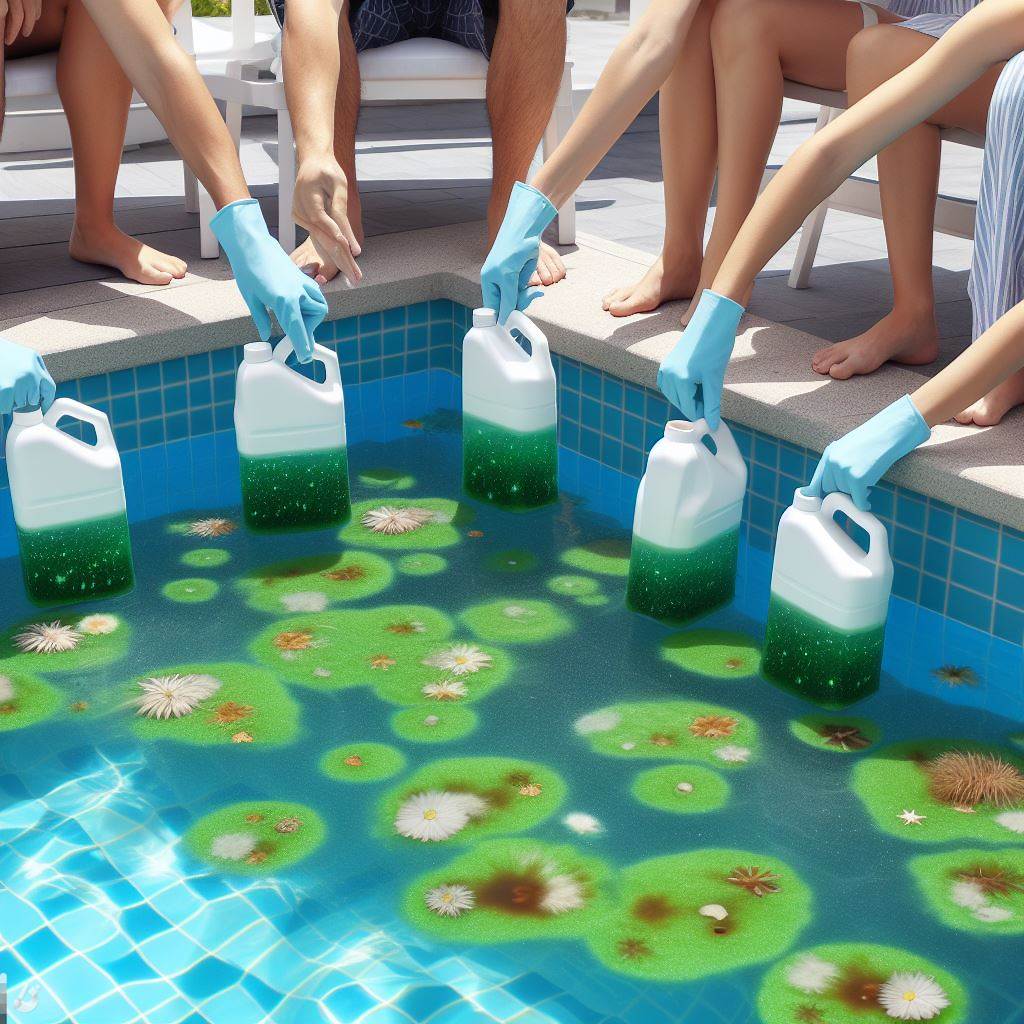Maintaining a crystal-clear and algae-free pool is essential for an enjoyable swimming experience. Algae growth can pose challenges to pool cleanliness and aesthetics. In this article, we will provide a detailed guide on the specific operational procedures for applying pool algaecides to combat algae, ensuring a pristine and inviting swimming environment.

Understanding Algae Growth
Before delving into the application process, it’s crucial to understand the factors that contribute to algae growth in swimming pools.
Common Algae Types:
Green algae, yellow/mustard algae, and black algae are common types that can thrive in different pool conditions.
Each type requires specific treatment approaches for effective control.
Causes of Algae Growth:
Factors such as inadequate sanitation, imbalanced water chemistry, sunlight exposure, and insufficient circulation can contribute to algae proliferation.
Regular pool maintenance practices are essential to prevent conditions favorable to algae.
Choosing the Right Algaecide
Selecting an appropriate algaecide is the first step in the algae control process.
Algaecide Types:
Quaternary ammonium compounds, copper-based algaecides, and polyquat algaecides are common types available.
Each type has specific strengths and considerations based on the algae type and pool conditions.
Compatibility with Pool Chemistry:
Ensure the chosen algaecide is compatible with the pool’s current water chemistry.
Follow manufacturer recommendations regarding water balance and compatibility.
Preparation and Safety Measures
Before applying algaecides, take necessary precautions to ensure safety and effectiveness.
Protective Gear:
Wear appropriate protective gear, including gloves and safety goggles, to prevent skin and eye contact.
Avoid wearing clothing that may absorb the algaecide.
Read and Follow Instructions:
Carefully read the manufacturer’s instructions on the algaecide product.
Follow dosage recommendations and safety guidelines to ensure proper application.
Water Testing and Balancing
Test the pool water and address any imbalances before applying algaecides.
Check pH Levels:
Ensure the pH level is within the recommended range (typically 7.2 to 7.8) for optimal algaecide effectiveness.
Adjust pH as needed using pH increasers or decreasers.
Optimal Alkalinity and Calcium Hardness:
Confirm that alkalinity and calcium hardness levels are within the recommended range.
Adjust alkalinity and calcium hardness using appropriate pool chemicals if necessary.
Removal of Debris and Brushing
Enhance algaecide effectiveness by preparing the pool surface.
Remove Debris:
Skim the pool surface to remove leaves, twigs, and other debris that may interfere with algaecide distribution.
Use a pool net or skimmer to collect floating debris.
Brush Pool Walls and Floor:
Brush pool walls and floor to loosen algae clinging to surfaces.
Focus on areas with visible algae growth or where circulation may be limited.
Application Process
Follow a systematic approach to applying algaecides for comprehensive coverage.
Even Distribution:
Apply the algaecide evenly across the pool surface.
Pour the algaecide in front of return jets for better distribution.
Targeted Areas:
Concentrate on areas prone to algae growth, such as shaded spots, corners, and steps.
Ensure proper circulation during application for uniform coverage.
Dosage Calculation:
Calculate the required algaecide dosage based on the pool size and the specific product’s recommendations.
Use a pool calculator or consult product guidelines for accurate dosage.
Circulation and Filtration
Maximize algaecide effectiveness by optimizing pool circulation and filtration.
Run the Pump and Filter:
Keep the pool pump and filter running during and after algaecide application.
Continuous circulation helps distribute the algaecide and facilitates filtration.
Backwashing and Cleaning:
Monitor the filter pressure and backwash the filter as needed to maintain optimal filtration.
Regularly clean the skimmer and pump baskets to prevent clogs.
Post-Application Testing and Adjustments
After algaecide application, conduct additional water testing and make necessary adjustments.
Testing Algaecide Levels:
Test the algaecide concentration in the pool water to ensure it falls within the recommended range.
Adjust dosage if needed based on test results.
Recheck Water Chemistry:
Recheck pH, alkalinity, and calcium hardness after algaecide application.
Make any necessary adjustments to maintain balanced water chemistry.
Ongoing Maintenance Practices
To prevent future algae growth, incorporate ongoing maintenance practices.
Regular Chlorination:
Maintain proper chlorine levels to prevent algae resurgence.
Use stabilized chlorine products to ensure consistent chlorine levels.
Routine Brushing and Cleaning:
Continue routine brushing and cleaning to prevent algae attachment to pool surfaces.
Regularly remove debris and vacuum the pool to maintain cleanliness.
Monitor and Adjust:
Monitor pool water regularly and adjust chemical levels as needed.
Address any issues promptly to prevent the recurrence of algae.
Troubleshooting and Additional Treatments
In cases of persistent algae or other issues, consider additional treatments.
Algaecide Boosters:
Some algaecides may offer booster products for enhanced algae control.
Follow manufacturer recommendations for booster application.
Shock Treatment:
Conduct a shock treatment if algae growth is severe.
Use a chlorine shock product to rapidly raise chlorine levels.
Conclusion
Effectively applying algaecides in swimming pools requires a systematic approach, from careful preparation to post-application adjustments. By following this comprehensive guide, pool owners can tackle algae issues and maintain a pristine swimming environment. Regular water testing, ongoing maintenance practices, and a proactive approach to addressing potential algae triggers are key elements in ensuring a consistently clear and inviting pool for swimmers to enjoy.

 Instant
Quote
Instant
Quote Email
Us
Email
Us